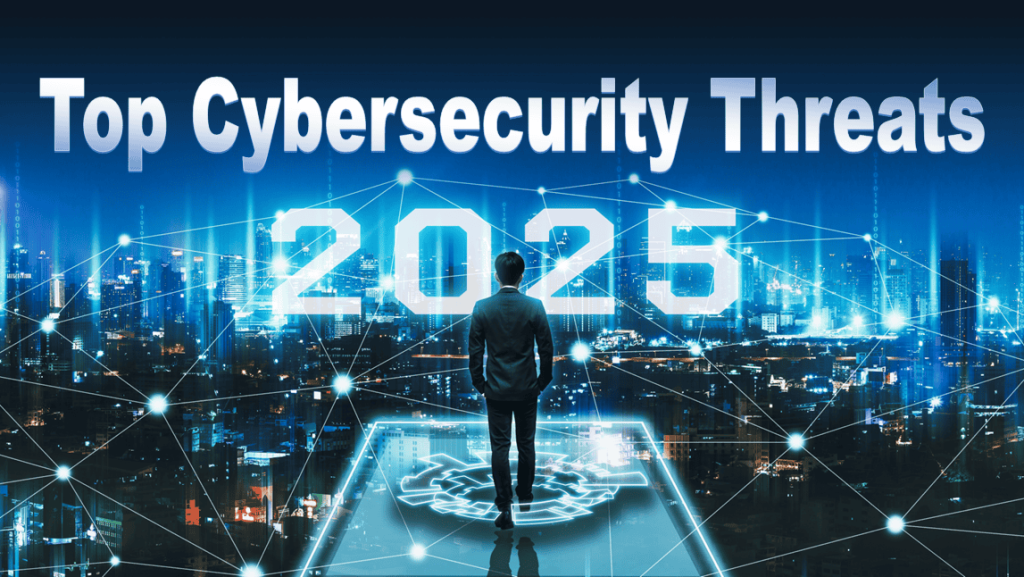In our increasingly connected world, cybersecurity is no longer optional — it’s a daily necessity. In 2025, hackers are smarter, AI tools are more sophisticated, and digital crimes are at an all-time high.
Whether you’re an individual, small business owner, or tech enthusiast, understanding today’s top cybersecurity threats can help you protect yourself before it’s too late.
Let’s explore the biggest online risks of 2025 — and what you can do right now to stay safe.

1. AI-Powered Phishing Attacks
Phishing isn’t new — but in 2025, it’s smarter and more dangerous. Cybercriminals are now using AI to write convincing emails and text messages, mimicking your bank, coworkers, or even family members.
Some advanced phishing attacks even generate personalized deepfake voice messages to trick victims into transferring money or sharing sensitive data.
How to Stay Safe:
- Never click links in unsolicited emails or texts.
- Verify sender details before responding.
- Use an AI-powered email filter like Microsoft Defender or Google Workspace security tools.
🔗 Learn more: Federal Trade Commission (FTC) – Recognizing and Avoiding Phishing Scams
2. Deepfake Scams and Impersonation Fraud
AI-generated deepfakes are now being used for scams, blackmail, and misinformation. In 2025, there have been cases where CEOs were tricked by fake video calls, authorizing massive fund transfers.
How to Stay Safe:
- Be cautious of video or voice calls that seem “slightly off.”
- Confirm sensitive requests through a secondary communication channel.
- Use deepfake detection tools such as Reality Defender or Deepware Scanner.
3. Ransomware-as-a-Service (RaaS)
Ransomware is evolving into a full-fledged business model — called Ransomware-as-a-Service. Even non-technical criminals can rent ransomware kits online, making attacks more frequent and devastating.
Victims often lose access to files, systems, or entire company databases until a ransom is paid — often in cryptocurrency.
How to Stay Safe:
- Regularly back up important data (both cloud + offline).
- Keep your OS and antivirus software updated.
- Avoid downloading software from unknown sources.
🔗 Read more: CISA’s Guide to Ransomware Protection
4. Smart Home & IoT Device Hacking
As smart homes become mainstream, hackers now target IoT devices — like smart locks, cameras, thermostats, and even baby monitors. Many of these devices lack strong security protocols.
How to Stay Safe:
- Change all default passwords immediately.
- Keep smart home firmware updated.
- Use a separate Wi-Fi network for IoT devices.
- Consider routers with built-in cybersecurity, like Eero Secure or Asus AiProtection.
5. AI-Driven Data Breaches
In 2025, hackers use AI to find system vulnerabilities faster than ever. These tools can automatically scan the web for weak passwords, outdated plugins, or open databases — putting millions of users at risk.
How to Stay Safe:
- Enable two-factor authentication (2FA) on all accounts.
- Rotate passwords every few months using a password manager (like 1Password or Bitwarden).
- Avoid reusing passwords across platforms.
6. Cloud Security Risks
With more companies moving to the cloud, misconfigured servers and weak access controls are among the top causes of data leaks in 2025.
How to Stay Safe:
- Use zero-trust security models.
- Encrypt sensitive files before uploading to the cloud.
- Audit your cloud permissions regularly.
🔗 External Resource: IBM Cloud Security Reports 2025
7. Mobile Payment & Banking App Exploits
Mobile payment apps like Apple Pay, Google Wallet, and Cash App are convenient — but they’ve also become hot targets. Attackers exploit fake app clones and insecure Wi-Fi connections.
How to Stay Safe:
- Only download apps from official stores.
- Avoid making payments over public Wi-Fi.
- Enable biometric authentication (Face ID, fingerprint).
8. Social Engineering via AI Bots
AI bots are being used on social media and messaging apps to manipulate conversations, gather personal data, or spread misinformation. These bots can mimic human-like chat patterns to earn your trust.
How to Stay Safe:
- Don’t overshare personal details online.
- Be skeptical of strangers asking for money or favors.
- Report suspicious accounts to platform moderators.
9. Quantum Computing Threats (Emerging Risk)
Quantum computers could soon break traditional encryption methods that protect your data. While still emerging, experts warn that hackers may already be harvesting encrypted data today to decrypt later.
How to Stay Safe:
- Transition to quantum-resistant encryption where possible.
- Stay informed on updates from NIST’s post-quantum cryptography research.
10. Human Error – The Hidden Threat
Despite all the tech, the biggest cybersecurity risk remains people. Clicking a wrong link, sharing passwords, or ignoring updates can compromise even the strongest systems.
How to Stay Safe:
- Educate yourself and your team regularly.
- Follow cybersecurity training programs like Google Cybersecurity Course (Coursera).
- Always verify before you trust.
Conclusion
Cybersecurity in 2025 is not just about having antivirus software — it’s about staying alert, proactive, and informed.
Hackers now use AI and automation, but you can stay one step ahead by:
- Updating devices regularly
- Using password managers and VPNs
- Securing your smart home
- Practicing safe browsing habits
By understanding today’s top threats and applying these safety measures, you can enjoy the convenience of modern technology without sacrificing your digital safety.
FAQs
Q1: What’s the biggest cybersecurity threat in 2025?
AI-powered phishing and ransomware are currently the most dangerous global threats.
Q2: How can I secure my personal data online?
Use strong passwords, 2FA, and a reliable VPN (like NordVPN or ExpressVPN).
Q3: Are antivirus programs still useful?
Absolutely. Modern antivirus software like Bitdefender, Norton 360, and Kaspersky use AI-based detection to block new threats.
Q4: Should I worry about deepfake scams?
Yes — always verify video or audio messages that request sensitive actions or payments.
READ ALSO:How to Build a Smart Home in 2025 (Step-by-Step Guide)